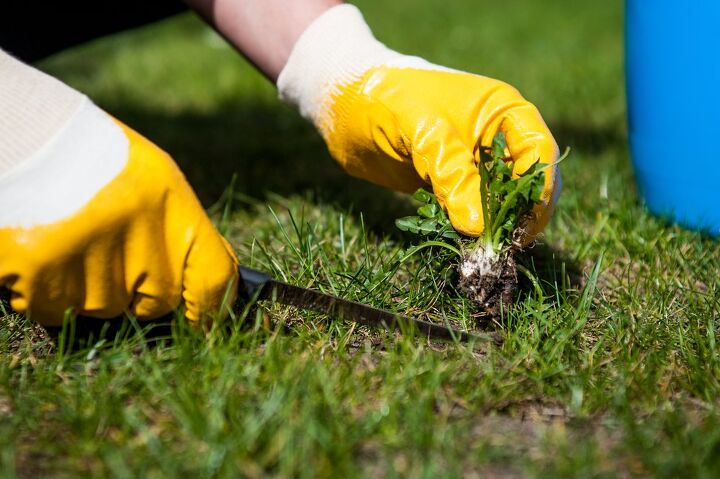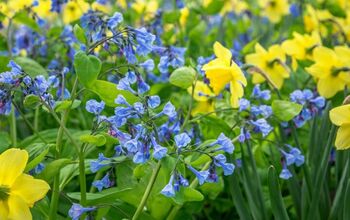How To Prevent Weeds In The Spring

The sight of weeds is enough to ruin the perfect picture of your beautiful yard and garden. By summer, weeds are in full force, so it’s important to treat the root (literally) of the problem throughout the spring. Many homeowners understandably struggle with how to prevent weeds in the spring.
The best way to prevent weeds in spring is to apply a pre-emergent herbicide spray. While effective, weeds will still eventually pop up, and you can kill them with a post-emergent spray. Mulch your garden to suppress weed growth and avoid cutting your grass too short. Tall, thick grass makes it harder for weeds to grow.
It’s also important to water your lawn and garden deeply, so the grass and plant roots grow deep. Deep roots can suppress weed growth, so they don’t pop up. Follow along as we explore how to prevent weeds in the spring, so you can enjoy your yard.
8 Ways To Prevent Weed Growth This Spring
Whether it be watering your lawn deeply or mulching your garden, there are many ways to prevent weeds in the spring. However, you will quickly realize that it takes several methods to ensure a weed-free yard. Some methods are preventative and some are reactionary, but they all yield great results.
1. Check The Soil Temperature
Check the soil temperature throughout early spring to get ahead of your future weed problem. The soil temperature will tell you when to expect weeds to grow. Weeds typically sprout when the soil temperature reaches and stays above 50 degrees Fahrenheit.
By checking the temperature, you will know when it’s time to treat your yard for weeds. This will give you a head start so you can apply early weed treatments.
2. Mow Your Lawn Carefully
It’s tempting to mow your lawn short and clean the first time of the year. However, this can weaken your grass in some cases and it may not grow back thick. Thick grass suppresses weeds naturally and makes it harder for them to grow.
Set the mowing height to the highest or second-highest setting when you mow your lawn. Tall grass won’t let the weed seeds get enough sunlight to grow. You may have to mow your lawn more often, but the grass will be stronger and less susceptible to weed growth.
3. Apply A Pre-Emergent Herbicide
Pre-emergent herbicides can stop weeds in their tracks before they get a chance to grow. Wait 5 days after you mow your lawn before you apply a pre-emergent herbicide. Don’t mow your lawn for another 1-2 days after you apply the herbicide, so it has a chance to sink into the soil.
You can fertilize your lawn a week after you apply the pre-emergent herbicide. This will strengthen your lawn while it's weed-free. While pre-emergent herbicides are reliable, you will eventually see weeds sprout. That’s when it’s time to use a post-emergent herbicide spray.
4. Spray Your Lawn With Post-Emergent Herbicide
Spray your lawn with post-emergent herbicide when you notice weeds. Pre-emergent sprays help prevent the problem while post-emergent herbicides kill existing weeds. There is no timeline as to how long you should wait to apply post-emergent herbicide.
Instead, simply watch your yard closely to see weeds as they pop up. The best post-emergent weed killers include Ortho Weed B Gon Plus Crabgrass Control and Triplet SF. However, it’s important to read the label for any weed killer.
That’s because some weed killers are better for specific types of grass, like Kentucky bluegrass and fescue. Glyphosate is one of the strongest weed-killing chemicals, and it’s a common ingredient in herbicide sprays. Mow your lawn 24-48 hours after you apply a post-emergent weed killer.
5. Mulch Around Flower Beds And Trees
Weeds are a huge threat to flower beds and even trees. They choke the roots of flowers and kill them or hinder their growth. Luckily, mulch can create a barrier that suppresses weed growth and keep them at bay.
Mulch also helps retain water for healthy plant growth, and it prevents soil erosion. Early spring and fall are the best times to mulch your garden. It costs up to $70 per cubic yard to professionally mulch your garden.
However, it can cost as little as $20-$30 per cubic yard depending on the service you use. Mulch can work for up to 4-6 years, but many people apply more yearly. It ultimately depends on the condition of the mulch.
6. Carefully Pull Weeds As Needed
Pulling weeds isn’t fun, but it is sometimes necessary. This temporary solution will keep up appearances. Make sure to carefully pull the weeds so that the root comes out.
Otherwise, the weed will grow if you simply rip off the part of it that sticks out. It’s easier to pull weeds after it rains when they stand out the most. You’ll see them more clearly, and they’ll be easier to grip.
Hoe the soil when it’s dry to remove weeds. This is a great option if the weeds are short and hard to grab.
7. Water Your Yard Deeply
It may sound counter-intuitive, but deep watering can prevent weed growth. Deep watering typically refers to soaking the soil as far as 8 inches deep. This depth will encourage the roots to grow deep, which makes it hard for weeds to grow.
Deep watering also helps the soil retain moisture, and that’s great for healthy grass growth. However, be careful not to overwater your soil. That can lead to fungus and cause unhealthy soil erosion. Water each section of your yard with up to an inch of water to prevent erosion, and let it soak 8 inches deep.
8. Scald The Weeds
If you don’t want to use herbicides, you can simply kill weeds with hot water. The only downside of this method is that it isn’t selective. In other words, you may kill grass and surrounding plants if the hot water gets on them.
You should only scald weeds with boiling water if they are far away from grass and plants. Boil some water in your kitchen, bring the kettle outside, and pour it on the weeds. This will quickly kill the weeds on contact. Only use this method if you can avoid contact with other plants.
Is It Better To Pull Weeds Or Spray Them?
Both pulling weeds and spraying them with herbicides are effective treatments. That said, spraying weeds with an herbicide is the best way to eliminate them. Both pre- and post-emergent weed killer sprays are powerful for preventative and reactionary treatment.
The biggest downside of pulling weeds is that you won’t get long-term results. That said, the results of herbicide sprays don’t last forever either. However, you won’t disturb roots as much when you use a selective spray as opposed to pulling weeds.
It’s important to only use selective herbicide sprays. A selective herbicide spray only kills specific plants, such as weeds. Non-selective herbicides can kill your beautiful flowers and grass, so it’s important to read the label. While sprays are more effective, it’s still okay to pull weeds as needed.
Summing It Up
Treat your yard with a pre-emergent herbicide to prevent weed growth in spring. Once weeds appear, spray them with a post-emergent spray to kill them. Cut your grass on a higher setting that so it stands tall and prevents weeds from getting sunlight. It’s also important to mulch your garden and water it deeply so roots grow deep and prevent weed growth.
Related Guides:

Nick Durante is a professional writer with a primary focus on home improvement. When he is not writing about home improvement or taking on projects around the house, he likes to read and create art. He is always looking towards the newest trends in home improvement.
More by Nick Durante

















![10 Most Dangerous Neighborhoods in Baltimore [Updated]](https://cdn-fastly.upgradedhome.com/media/2023/07/31/9075655/10-most-dangerous-neighborhoods-in-baltimore-updated.jpg?size=350x220)









